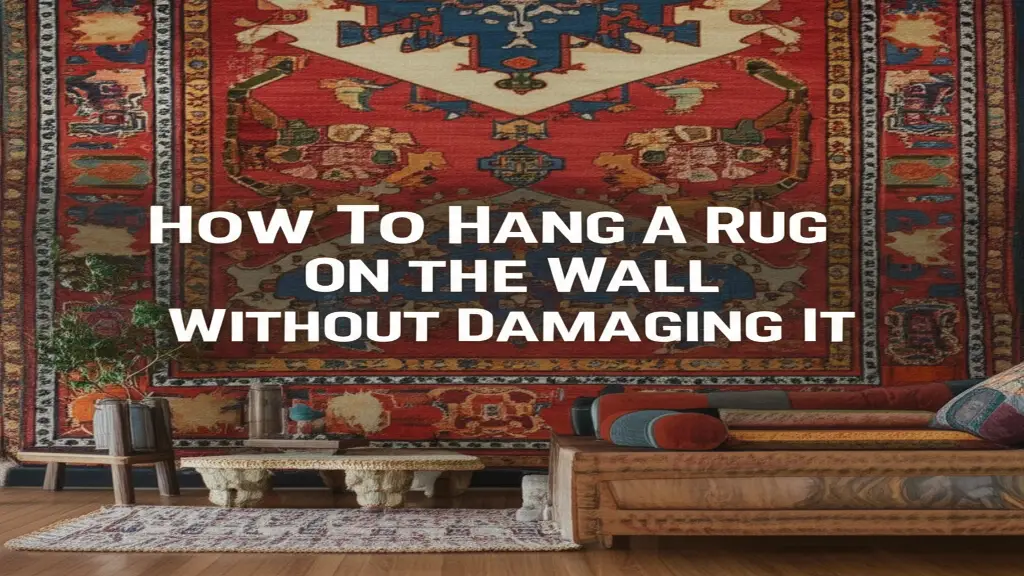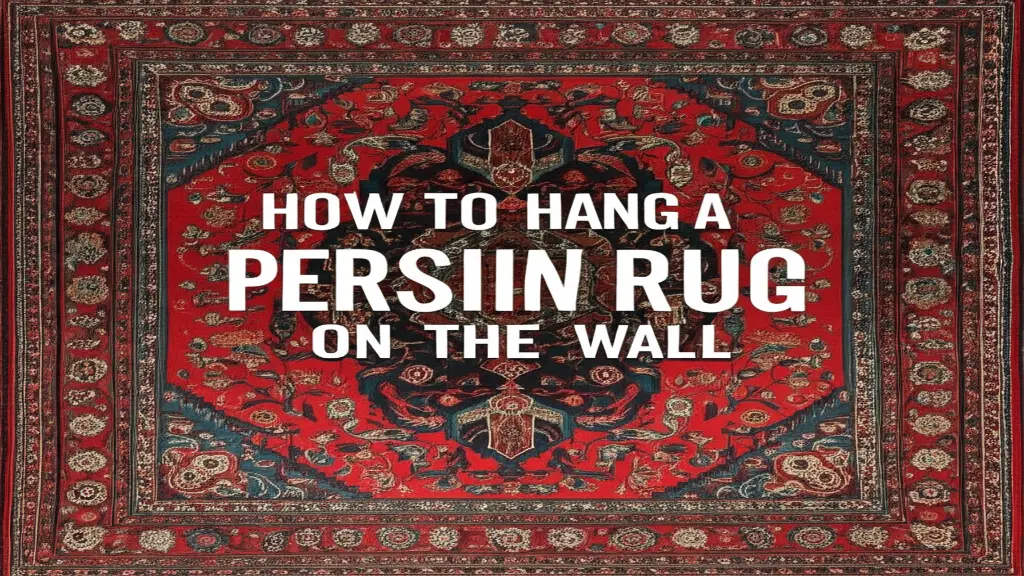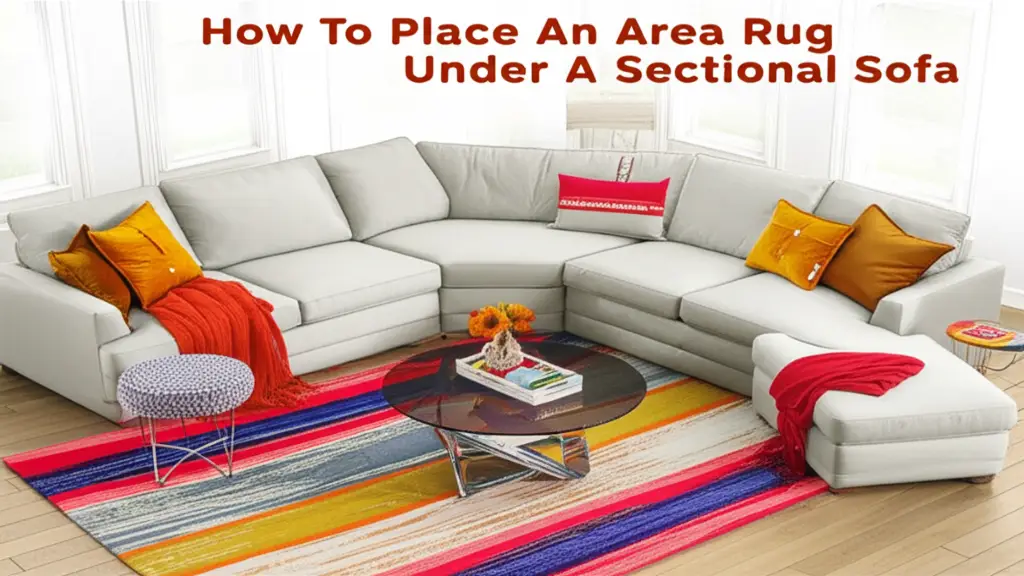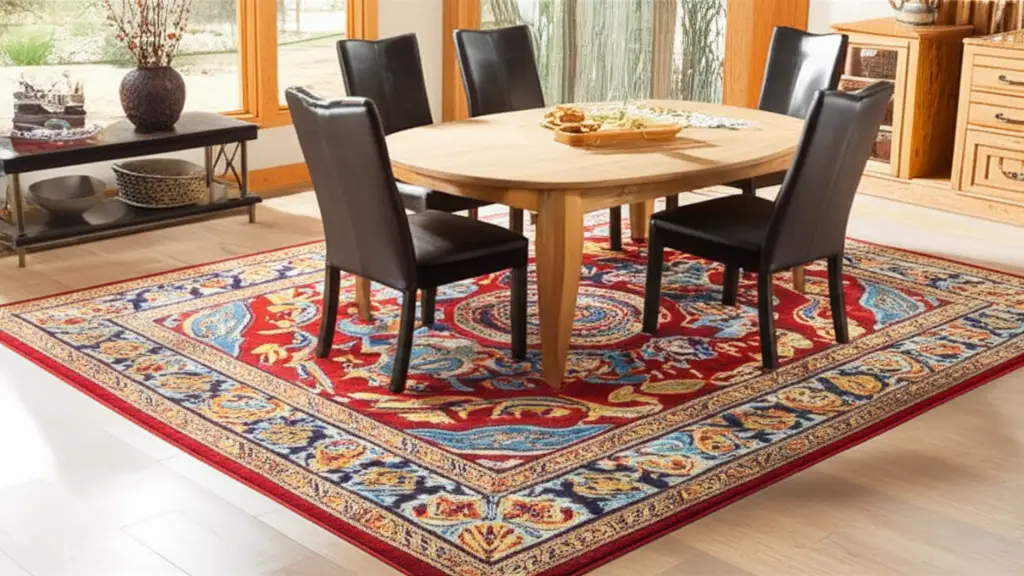· Todd Martin · Home Decor · 11 min read
How To Hang A Rug On The Wall Without Damaging It

How to Hang a Rug on the Wall Without Damaging It: Complete Guide
Transforming your living space with wall-hanging rugs can instantly add texture, color, and character to any room. Whether you’re displaying a cherished Persian heirloom, a vibrant textile from your travels, or simply repurposing a beautiful area rug, hanging rugs on walls creates dramatic visual interest without permanent modifications.
However, improper hanging methods can damage both your walls and your precious rugs. This comprehensive guide explores multiple damage-free techniques for how to hang a rug on the wall without harming either surface, suitable for various rug types and wall materials.
Key Takeaways
- Use velcro strips, rug hanging clips, or specialized hanging kits for no-damage installation
- Select mounting methods based on rug weight, size, and construction type
- Consider fabric backing for heavy or antique rugs to provide additional support
- Regular maintenance prevents sagging and extends the life of wall-hung rugs
- Temporary solutions like tension rods work well for renters and frequent redecorators
In short: Hanging a rug on your wall creates stunning visual impact while adding texture and warmth to your space. With the right damage-free mounting technique matched to your specific rug type, you can safely display textile art without compromising your walls or the rug itself.
Why Display Rugs as Wall Art?
Hanging rugs as wall décor isn’t just a current design trend—it’s a practice with deep historical roots. Tapestries and rugs have adorned castle walls for centuries, providing both decoration and insulation. Today, displaying rugs vertically offers numerous benefits:
- Showcases intricate patterns that might be hidden underfoot
- Preserves valuable or delicate rugs from foot traffic and wear
- Provides sound absorption and improves room acoustics
- Adds texture and warmth to stark wall spaces
- Creates dramatic focal points in rooms lacking architectural interest
- Offers temporary décor solutions for renters or frequent redecorators
Wall-hanging rugs work particularly well in spaces with high ceilings, minimalist décor, or rooms that need visual anchoring. They’re also perfect for displaying cultural textiles or rugs with sentimental value that you’d prefer not to walk on.
Before selecting a hanging method, consider your rug’s construction, weight, and condition. Lightweight kilims and flatweaves are easier to mount than heavy pile rugs or antique pieces that require more support. Proper assessment ensures you’ll choose the most appropriate damage-free hanging technique.
Best Damage-Free Methods for Hanging Rugs
1. Velcro Hanging Systems
Best for: Medium-weight rugs, rental properties, frequent repositioning
Velcro strips (hook-and-loop fasteners) offer one of the most versatile and wall-friendly methods for hanging rugs without damage. This approach works particularly well for how to hang a rug on the wall with velcro when you might want to reposition the piece occasionally.
Materials needed:
- Heavy-duty adhesive velcro strips
- Measuring tape
- Scissors
- Clean cloth and rubbing alcohol
Step-by-step process:
- Clean the wall surface with rubbing alcohol to remove oils and dust.
- Measure your rug and cut velcro strips to fit along the top edge (and sides for larger rugs).
- Attach the “hook” side of the velcro to the back of the rug, approximately 1-2 inches from the edge.
- With help from another person, hold the rug in position and mark where the corresponding velcro strips should go on the wall.
- Attach the “loop” side of the velcro to the wall, pressing firmly for 30 seconds.
- Wait at least one hour before hanging the rug to allow adhesive to set.
- Carefully press the rug’s velcro strips to the wall-mounted strips.
Pro tip: For heavier rugs, use additional velcro strips along the sides or in a grid pattern across the back for more support. Commercial-grade velcro typically holds up to 10 pounds per square foot when properly applied.
You can find specialty rug hanging velcro systems at home improvement stores or learn more about velcro hanging methods.
2. Rug Hanging Clips and Clamps
Best for: Lightweight to medium-weight rugs, preserving rug edges
Specialized rug hanging clips distribute weight evenly while preventing strain on any single part of the fabric. These are particularly useful when figuring out how to hang a small rug on the wall or how to hang a rug with fringe on the wall without damaging the delicate edges.
Materials needed:
- Rug hanging clips or clamps (6-12 depending on rug size)
- Small nails, adhesive hooks, or tension wire
- Level
- Measuring tape
- Hammer (if using nails)
Step-by-step process:
- Measure the width of your rug and mark where each clip should go on the wall, spacing them 8-12 inches apart.
- Install your hanging hardware of choice (adhesive hooks for damage-free installation).
- Attach clips to the top edge of the rug, being careful not to pinch fibers.
- Hang the clips on your installed hooks or wire.
- Adjust rug position until perfectly level.
Pro tip: For rugs with fringe, use specialty clips designed with extension tabs that hold the body of the rug while allowing the fringe to hang freely.
3. Rod Pocket Method
Best for: Lightweight rugs, preserving original condition, hanging without attachments
Creating a rod pocket allows you to hang a rug without attaching anything directly to the textile itself—ideal for preserving valuable or antique pieces.
Materials needed:
- Curtain rod with wall-friendly mounting hardware (adhesive hooks or tension rod)
- Cotton fabric strip
- Sewing supplies or fabric adhesive
- Iron
- Measuring tape
Step-by-step process:
- Cut a fabric strip a few inches longer than the width of your rug and about 6 inches wide.
- Fold and press the strip in half lengthwise.
- Position the strip along the top back edge of the rug.
- Hand-sew the strip to create a channel (or use fabric adhesive for a no-sew option).
- Install curtain rod using damage-free hardware.
- Slide the rod through the fabric channel and hang.
Pro tip: For a completely damage-free solution, use an expandable tension rod inside a rod pocket that fits between two walls—perfect for renters wondering how to hang a rug on the wall reddit users recommend for apartment living.
4. Rug Wall Hanging Kits
Best for: Larger or heavier rugs, professional-looking installation
Commercial rug hanging kits typically include everything needed for a clean, damage-free installation. These kits often use specialized mounting systems that distribute weight evenly.
Materials needed:
- Rug wall hanging kit
- Level
- Measuring tape
- Drill (if required by kit instructions)
Step-by-step process:
- Follow the specific instructions included with your kit.
- Most kits involve installing a mounting strip or brackets on the wall (many use adhesive options).
- Attach corresponding hardware to the rug backing.
- Connect the rug to the wall-mounted hardware.
Popular rug hanging kits include systems with interlocking strips, magnetic attachments, or sliding bracket designs. The best choice depends on your rug’s size and construction.
Special Considerations for Different Rug Types
How to Hang a Tufted Rug on Wall
Tufted rugs require special care due to their construction and weight. The backing of these rugs often isn’t designed to support the weight of vertical hanging.
Best approach: Create a full fabric backing support that covers the entire reverse side of the rug, then attach hanging hardware to this backing rather than directly to the rug. Alternatively, consider mounting the rug on a lightweight wooden frame before hanging.
How to Hang a Rug with Fringe on the Wall
Fringe requires particular attention to prevent stretching or tearing under the rug’s weight.
Best approach: Use clip systems specifically designed for fringed rugs, which grip the main body of the rug without putting pressure on the fringe. Another option is the rod pocket method, which allows the fringe to hang freely while supporting the rug’s weight from above.
For more detailed guidance on hanging specific types of rugs like Persian or Oriental varieties, check out this specialized guide.
How to Hang a Small Rug on the Wall
Smaller rugs offer more flexibility in hanging methods but still benefit from proper support.
Best approach: Lightweight options like adhesive velcro strips or decorative rug hanging clips work particularly well for small rugs. For very light pieces, even fabric-friendly adhesive strips placed directly on the rug backing can work effectively.
Creative and Unique Display Ideas
Beyond basic hanging methods, consider these distinctive approaches for displaying rugs:
- Stretched canvas method: Mount your rug on a wooden frame like an artist’s canvas for a gallery-style presentation.
- Shadow box display: Frame valuable or antique textile fragments in deep shadow boxes for preservation and display.
- Quilting hoop showcase: Display small rug fragments or sections in oversized quilting hoops for a crafty, bohemian look.
- Hanging multiple rugs: Create a gallery wall of smaller rugs using consistent mounting hardware for a cohesive look.
For pet owners wondering how to hang a rug on the wall for cats, consider mounting rugs on sturdy frames securely anchored to wall studs to create scratch-friendly surfaces that won’t come down during enthusiastic scratching sessions.
Maintenance Tips for Wall-Hung Rugs
Proper ongoing care extends the life of your wall-displayed textiles:
- Regular gentle vacuuming with a brush attachment prevents dust accumulation.
- Rotate rugs periodically to prevent uneven fading from sunlight exposure.
- Check mounting hardware quarterly to ensure everything remains secure.
- Remove and air out rugs twice yearly to prevent musty odors or pest issues.
- Keep rugs away from direct heat sources which can dry fibers and adhesives.
For large or valuable rugs, professional cleaning every 1-2 years helps preserve colors and fibers. Learn more about proper rug cleaning techniques to maintain your wall hangings.
Troubleshooting Common Issues
Sagging or Uneven Hanging
If your rug begins to sag:
- Add additional support points across the width
- Consider a more robust mounting system
- Install a lightweight backing for better structure
Wall Damage Despite Precautions
If you notice wall damage:
- Remove the hanging system immediately
- Allow the wall to dry completely if adhesive residue is present
- Patch any damaged areas before trying an alternative mounting method
Rug Damage from Improper Hanging
If your rug shows signs of stress:
- Redistribute weight with additional support points
- Consider a different hanging method that puts less strain on fibers
- Consult a textile conservator for valuable or antique pieces
FAQ: Common Questions About Hanging Rugs
How to frame a rug for hanging without nails?
You can create a simple frame using lightweight wood strips attached to the rug with fabric adhesive or stitching. The framed rug can then be hung using adhesive hooks or strips designed for picture hanging. For valuable rugs, professional framing with archival materials offers the best protection.
How do you hang a wall hanging without damaging it?
The safest methods include using adhesive velcro strips, command hooks with rug clips, tension rods with fabric sleeves, or professional hanging systems designed specifically for textiles. Always distribute weight evenly across multiple points rather than concentrating stress on a few areas.
What kind of nails do you need to hang a rug on the wall?
If you must use nails, choose specialty upholstery tacks with wide, flat heads that distribute pressure. However, for truly damage-free installation, avoid nails entirely and opt for adhesive hanging systems or tension-based methods that require no wall penetration.
Why do people hang rugs on walls?
People display rugs on walls for numerous reasons: to showcase intricate patterns or craftsmanship, preserve valuable pieces from foot traffic, improve room acoustics, add texture and warmth to décor, create dramatic focal points, or display cultural textiles with significance beyond floor covering.
Can I hang a heavy wool rug on drywall?
Yes, but you’ll need a mounting system that distributes weight across multiple attachment points. For rugs weighing more than 15 pounds, consider installing a wooden batten system anchored to wall studs, then attaching the rug to this support structure rather than directly to the drywall.
How do I prevent my wall-hung rug from collecting dust?
Regular gentle vacuuming with a brush attachment prevents dust buildup. Alternatively, periodically take the rug down and gently shake it outdoors. Keeping rugs away from high-traffic areas and air vents also reduces dust accumulation.
Can I hang rugs in humid environments like bathrooms?
It’s generally not recommended to hang valuable rugs in bathrooms or other high-humidity areas, as moisture can damage fibers and promote mold growth. If you do want textile art in these spaces, choose synthetic rugs specifically designed for moisture resistance and ensure good ventilation.
Final Words
Hanging rugs on walls transforms ordinary textiles into spectacular art pieces while preserving beautiful craftsmanship for years to come. By choosing the right damage-free hanging method for your specific rug type, you can create stunning visual impact without compromising your walls or the rug itself. Whether you’re working with a lightweight kilim, a tufted contemporary piece, or a valuable antique with delicate fringe, there’s a safe hanging solution perfect for your needs.
Remember that proper distribution of weight and regular maintenance are key to successful rug wall displays. For particularly valuable or antique rugs, consulting with a textile conservator before hanging can provide peace of mind and preservation expertise.
Ready to transform your space with vertical textile art? Start with smaller pieces to perfect your technique before tackling larger installations. Your walls—and your rugs—will thank you for the careful consideration and proper mounting methods outlined in this guide. For more information on rug care and maintenance, explore our comprehensive rug care guides.





